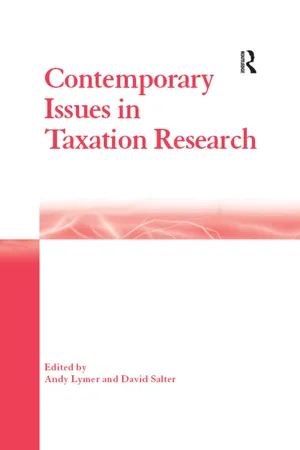
- 264 pages
- English
- ePUB (mobile friendly)
- Available on iOS & Android
Contemporary Issues in Taxation Research
About This Book
This book is based upon papers presented at the 10th Annual Conference of the Tax Research Network held at the University of Birmingham, United Kingdom, in September 2000. The book covers four discrete areas namely compliance, e-commerce and taxation, international taxation and taxation within the European Union, and value added tax, and focuses within those areas on issues of topical and continuing interest. In an introductory chapter, the editors provide an overview of the subject matter of each of the substantive chapters (of which there are eleven). They conclude by seeking to extrapolate from those chapters, notwithstanding their diversity, various matters of wider and contemporary import to taxation. The treatment of the material in this book by scholars from various academic disciplines and with differing geographical perspectives also gives distinct and instructive insights into widely recognised and enduring taxation problems within the above-mentioned subject areas. Further, an appreciation and understanding of the multi-faceted approaches which may be adopted for problem solving, and which are evident in this book, can only enhance the prospects of the ultimate resolution of these problems.
Frequently asked questions
PART I:
COMPLIANCE
Chapter 3
Tax Practitioners and Tax Compliance
Introduction
General overview
Decision to engage a tax practitioner
Author(s)/Date/Method/DV | Subjects | Manipulations/Controls used | Primary findings |
|---|---|---|---|
Collins et al. (1990) 1 if professional preparer engaged and 0 if taxpayer prepares own return. Mail survey | 700 households (Oklahoma and Pennsylvania). | Mail Questionnaire on tax minimisation and most correct return. | Most correct return more effective than tax minimisation. |
Christensen (1992) D.V:7-point Likert scales, strongly disagree to strongly agree. Mail survey | 441 clients 31 tax preparers in 3 firms. | Mail Questionnaire on quality tax service (Technical and Functional quality). | Technical quality more effective than functional quality. |
Hite and McGill (1992) D.V: 9-point scale, definitely yes to definitely no. Mail survey | 262 residents from 3 sources: Telephone listings, driver licences, voter registrations. | Mail Questionnaire on tax practitioners’ recommendation, prob. of audit and severity of sanctions. | Subjects agree with conservative advice and disagree with aggressive advice. |
Hite et al. (1992) D.V: 9-point Likert scales, 1 strongly agree to 9 strongly disagree. Mail survey | Nation wide survey of 300 small business owners. | Mail Questionnaire on why SBOs use tax practitioner. | Four potential motivations for an SBO to use a tax practitioner: 1. To have the return prepared correctly 2. To pay the least tax required 3. To avoid serious tax penalties or 4. To reduce the chances of being audited. |
Schisler (1995) D.V: Equity probability of recommending deduction, on 0-100 scales, Consensus. Lab experiment | 125 evening MBA students and 127 Big 6 CPAs. | 30 minute scenario on Preparer status, withholding status, penalty. | Preparers had higher equity opinions; preparer status and withholding status significantly affected deduction decisions; taxpayers were significantly more aggressive with tax due; preparers had higher consensus. |
Christensen and Hite (1997) D.V: 2 response scale 1 (definitely would not claim the deduction or not report the income) to 9 (definitely would claim the deduction or report the income) risk averse, risk seeking. Mail survey | 466 middle to upper income U.S. residents from 3 sources: telephone directories, voter registration, driver licence lists in all 50 states. | Mail Questionnaire on income/deduction issue, level of certainty, winning/losing an IRS challenge. | Significant differences in the factors that affect risk averse taking individuals risk averse are influenced by outcomes being described in terms of winning or losing and IRS challenge. Risk takers are quite sensitive to higher probabilities of success. Taxpayers take more aggressive positions when the item in question is a deduction rather than additional income. |
Tan (1999) D.V: The extent of agreement or disagreement with tax practitioner’s advice. 9-point scale (from definitely yes to definitely no). Mail survey | 800 business firms, randomly sampled from the Yellow Pages of the telephone directory. | 8 scenarios on aggressive and conservative advice (on tax deduction). | Conservative advice more effective than aggressive advice. |
Table of contents
- Cover
- Half Title
- Title Page
- Copyright Page
- Table of Contents
- Acknowledgements
- List of Contributors
- INTRODUCTION
- PART I: COMPLIANCE
- PART II: E-COMMERCE AND TAXATION
- PART III: INTERNATIONAL TAXATION: INTERNATIONAL AND EUROPEAN UNION INITIATIVES
- PART IV: VALUE ADDED TAX
- Index